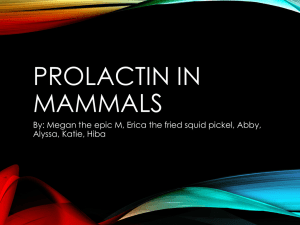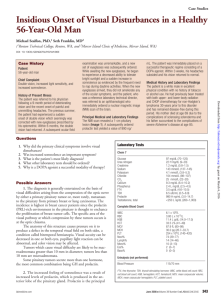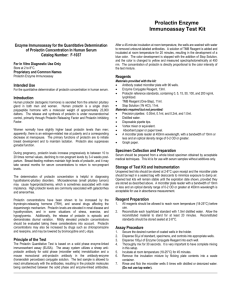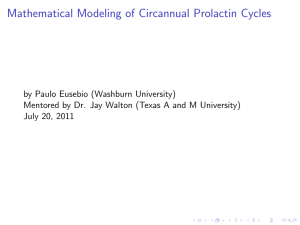Prolactin and helping in birds: has natural selection strengthened helping behavior?
advertisement
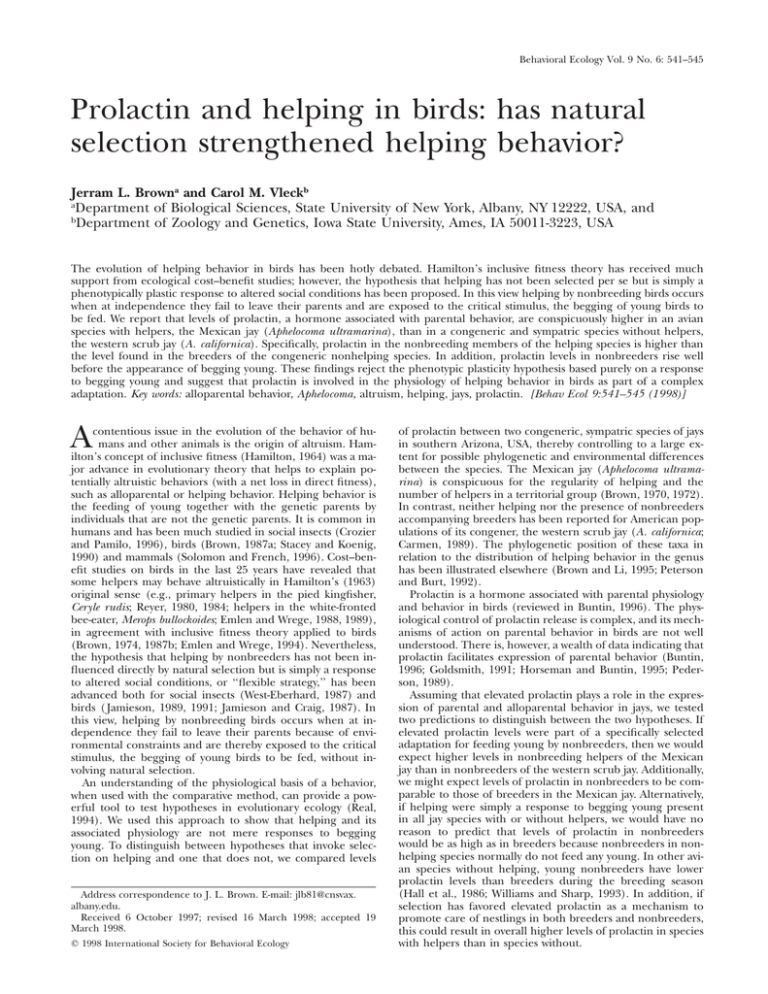
Behavioral Ecology Vol. 9 No. 6: 541–545 Prolactin and helping in birds: has natural selection strengthened helping behavior? Jerram L. Browna and Carol M. Vleckb aDepartment of Biological Sciences, State University of New York, Albany, NY 12222, USA, and bDepartment of Zoology and Genetics, Iowa State University, Ames, IA 50011-3223, USA The evolution of helping behavior in birds has been hotly debated. Hamilton’s inclusive fitness theory has received much support from ecological cost–benefit studies; however, the hypothesis that helping has not been selected per se but is simply a phenotypically plastic response to altered social conditions has been proposed. In this view helping by nonbreeding birds occurs when at independence they fail to leave their parents and are exposed to the critical stimulus, the begging of young birds to be fed. We report that levels of prolactin, a hormone associated with parental behavior, are conspicuously higher in an avian species with helpers, the Mexican jay (Aphelocoma ultramarina), than in a congeneric and sympatric species without helpers, the western scrub jay (A. californica). Specifically, prolactin in the nonbreeding members of the helping species is higher than the level found in the breeders of the congeneric nonhelping species. In addition, prolactin levels in nonbreeders rise well before the appearance of begging young. These findings reject the phenotypic plasticity hypothesis based purely on a response to begging young and suggest that prolactin is involved in the physiology of helping behavior in birds as part of a complex adaptation. Key words: alloparental behavior, Aphelocoma, altruism, helping, jays, prolactin. [Behav Ecol 9:541–545 (1998)] A contentious issue in the evolution of the behavior of humans and other animals is the origin of altruism. Hamilton’s concept of inclusive fitness (Hamilton, 1964) was a major advance in evolutionary theory that helps to explain potentially altruistic behaviors (with a net loss in direct fitness), such as alloparental or helping behavior. Helping behavior is the feeding of young together with the genetic parents by individuals that are not the genetic parents. It is common in humans and has been much studied in social insects (Crozier and Pamilo, 1996), birds (Brown, 1987a; Stacey and Koenig, 1990) and mammals (Solomon and French, 1996). Cost–benefit studies on birds in the last 25 years have revealed that some helpers may behave altruistically in Hamilton’s (1963) original sense (e.g., primary helpers in the pied kingfisher, Ceryle rudis; Reyer, 1980, 1984; helpers in the white-fronted bee-eater, Merops bullockoides; Emlen and Wrege, 1988, 1989), in agreement with inclusive fitness theory applied to birds (Brown, 1974, 1987b; Emlen and Wrege, 1994). Nevertheless, the hypothesis that helping by nonbreeders has not been influenced directly by natural selection but is simply a response to altered social conditions, or ‘‘flexible strategy,’’ has been advanced both for social insects (West-Eberhard, 1987) and birds ( Jamieson, 1989, 1991; Jamieson and Craig, 1987). In this view, helping by nonbreeding birds occurs when at independence they fail to leave their parents because of environmental constraints and are thereby exposed to the critical stimulus, the begging of young birds to be fed, without involving natural selection. An understanding of the physiological basis of a behavior, when used with the comparative method, can provide a powerful tool to test hypotheses in evolutionary ecology (Real, 1994). We used this approach to show that helping and its associated physiology are not mere responses to begging young. To distinguish between hypotheses that invoke selection on helping and one that does not, we compared levels Address correspondence to J. L. Brown. E-mail: jlb81@cnsvax. albany.edu. Received 6 October 1997; revised 16 March 1998; accepted 19 March 1998. q 1998 International Society for Behavioral Ecology of prolactin between two congeneric, sympatric species of jays in southern Arizona, USA, thereby controlling to a large extent for possible phylogenetic and environmental differences between the species. The Mexican jay (Aphelocoma ultramarina) is conspicuous for the regularity of helping and the number of helpers in a territorial group (Brown, 1970, 1972). In contrast, neither helping nor the presence of nonbreeders accompanying breeders has been reported for American populations of its congener, the western scrub jay (A. californica; Carmen, 1989). The phylogenetic position of these taxa in relation to the distribution of helping behavior in the genus has been illustrated elsewhere (Brown and Li, 1995; Peterson and Burt, 1992). Prolactin is a hormone associated with parental physiology and behavior in birds (reviewed in Buntin, 1996). The physiological control of prolactin release is complex, and its mechanisms of action on parental behavior in birds are not well understood. There is, however, a wealth of data indicating that prolactin facilitates expression of parental behavior (Buntin, 1996; Goldsmith, 1991; Horseman and Buntin, 1995; Pederson, 1989). Assuming that elevated prolactin plays a role in the expression of parental and alloparental behavior in jays, we tested two predictions to distinguish between the two hypotheses. If elevated prolactin levels were part of a specifically selected adaptation for feeding young by nonbreeders, then we would expect higher levels in nonbreeding helpers of the Mexican jay than in nonbreeders of the western scrub jay. Additionally, we might expect levels of prolactin in nonbreeders to be comparable to those of breeders in the Mexican jay. Alternatively, if helping were simply a response to begging young present in all jay species with or without helpers, we would have no reason to predict that levels of prolactin in nonbreeders would be as high as in breeders because nonbreeders in nonhelping species normally do not feed any young. In other avian species without helping, young nonbreeders have lower prolactin levels than breeders during the breeding season (Hall et al., 1986; Williams and Sharp, 1993). In addition, if selection has favored elevated prolactin as a mechanism to promote care of nestlings in both breeders and nonbreeders, this could result in overall higher levels of prolactin in species with helpers than in species without. Behavioral Ecology Vol. 9 No. 6 542 The timing of the seasonal rise in prolactin may also be used to test the hypothesis that selection has not acted to cause a difference between species with helpers and species without. If helping has been selected for feeding young, then prolactin levels in nonbreeding helpers would be expected to rise before the production of begging calls in a manner similar to that of breeders. Conversely, if a rise in prolactin were simply a response to begging young, it should follow the stimulus, not precede it. Our second prediction, therefore, was that prolactin levels of nonbreeders in the Mexican jay would rise before the first occurrence of the postulated external stimulus, the begging of young birds. MATERIALS AND METHODS We studied a population of the Mexican jay in the Chiricahua Mountains in 1991, 1994, and 1996 and two populations of western scrub jays, one near the Sierrita Mountains (1993) and the other in the Santa Catalina Mountains (1995). These two species have extensive behavioral and ecological contact in the Chiricahua Mountains, Santa Catalina Mountains, and probably throughout southeastern Arizona. Their interactions have been studied in the Chiricahua Mountains by E. Greene (personal communication). We knew the age and breeding status of nearly all of the Mexican jays in our study area because the population is the subject of a long-term study (Brown, 1994) and because essentially all nests are located each year. Birds were aged, sexed, and color-banded according to standard methods (Brown et al., 1997). Breeders were defined as birds that laid eggs or were mated to a female that laid eggs in the same year. For the western scrub jay we trapped and color-banded birds at feeders throughout the study site. In only a few cases could we assign sex based on behavior or brood patch (a female trait) or breeding status based on attendance at a nest. The nesting season for the western scrub jay is not as well studied as that of the Mexican jay, but it generally occurs at the same time. At our study sites the earliest incubating female scrub jay was found in late March and the latest was found in late May. Most nest-building activity occurred in late March through April, and most feeding of nestlings was observed in May. These dates are similar to those for the Mexican jays we studied (Brown and Li, 1996). In addition, the elevation in sex steroids occurs at the same time in both species (Vleck et al., 1996), further suggesting coincidence of the nesting seasons. We took blood samples from the wing vein in the late winter, the end of the nonbreeding season, and in the breeding season, March–June, from both species. All blood samples were obtained immediately after capture and were collected between dawn and noon. Blood was kept on ice for no more than 4 h. It was then centrifuged, separated into plasma, and the cells and the plasma were stored at 2208C until assayed. We determined plasma levels of prolactin in duplicate 20-ml volumes of plasma in the laboratory using a postprecipitation, double-antibody radioimmunoassay supplied by A. F. Parlow. This assay uses purified chicken prolactin as a standard and an antisera raised in rabbits against chicken prolactin. Crossreactivity with chicken growth hormone is ,1%. The assay has recently been validated for use in another species of Aphelocoma (Schoech et al., 1996). Dilutions of a plasma pool from Mexican jays or from western scrub jays showed reasonable cross-reactivity with the antisera, and slopes of the logit-transformed curves for these two species did not differ from the slope of the diluted chicken standard in a three-slope comparison (ANCOVA, F2,26 5 2.42, p 5 .11). The mean intraassay and interassay coefficients of variation were 6.6% and 14.6%, respectively. We obtained 119 prolactin values from 94 Mexican jays and 56 values from 50 western scrub jays. Samples from the 12 Mexican jays that were resampled in the same year were separated in time by an average of 47 days (SD 5 27, minimum 5 28 days), and samples from four western scrub jays resampled in the same year were separated in time by an average of 25 days (SD 5 12, minimum 5 6 days). Repeated-measures of prolactin in the same individual had no effect in either the Mexican jay (F22,26 5 0.57, p 5 .91) or the western scrub jay (F3,7 5 .13, p 5 .94); consequently, we used all the values for our analyses except for the two-species comparison, in which case we used data only from birds sampled one time. Data from multisampled birds were not used at all. In the Mexican jay we examined the effect of sex, breeding status, and age on prolactin level mid-April through May, Julian days 105–151, the interval when it was most elevated. This is the interval during which eggs or nestlings are present. The mean date of the third egg of the first clutch in the group for all years was April 14 (SD 5 13 days). RESULTS In the Mexican jay prolactin was significantly higher in females than in males during the incubation/nestling phase (t1,30 5 23.10, p 5 .004). The mean value for male prolactin was 23.2 ng/ml (SD 5 4.09, n 5 24), whereas the mean value for females was 28.4 ng/ml (SD 5 4.73, n 5 8). Both of these values are much higher than those found in any western scrub jays, so we combined the data from Mexican jay males, females, and birds of unknown sex (n 5 65) for comparison with the western scrub jay. We knew the sex of 10 western scrub jays: 7 females and 3 males. In this subsample there was no significant effect of sex on prolactin (t1,8 5 .97, p 5 .36), so we combined the sexes in the analysis (n 5 56). There was no significant effect of year in the analysis for either western scrub jay (F1.54 5 0.68, p 5 .41) or Mexican jays analyzed separately by sex (females: F2,5 5 2.557, p 5 .17; males: F2,23 5 3.08, p 5 .07; unknown sex: F2,37 5 1.48, p 5 .24). Neither breeding status (F1,72 52.26, p 5 .14) nor age had a significant effect on prolactin in the Mexican jay (regression analysis, F1,72 5 0.33, p 5 .56). Yearlings and most 2-year-old Mexican jays do not breed, but yearling prolactin values (mean 5 23.3 ng/ml, SD 5 4.23, n 5 16) did not differ from prolactin for all other age classes combined (mean 5 24.0, SD 5 4.23, n 5 58; t1,72 5 20.64, p 5 .52). Thus, young nonbreeding Mexican jays, most of which were observed helping feed young, had prolactin levels as high as breeding Mexican jays and more than double the value found in western scrub jays whether they were breeders or nonbreeders (see below). During the time interval for which we have data from both species (March through early June, Julian days 60–155), the level of prolactin in Mexican jays was significantly higher than it was in western scrub jays (Figure 1; t1,93 5 12.98, p , .0001). Mean prolactin during this interval in the Mexican jay was 23.2 ng/ml (SD 5 5.88, n 5 51), whereas it was only 9.5 ng/ ml in the western scrub jay (SD 5 4.07, n 5 44). It was not possible for us to distinguish breeding and nonbreeding western scrub jays in most cases, so we cannot say with certainty that nonbreeders have lower prolactin levels than breeders. The inclusion of some nonbreeding western scrub jays with relatively low prolactin may account for the higher coefficient of variation (CV 5 43) in this species than in the Mexican jay (CV 5 25). In our test of the second prediction derived from the flexible strategy hypothesis, prolactin levels in Mexican jays rose in all individuals well before the first appearance of begging nestlings (Figure 2). Although the levels rose earlier (even before incubation) in the breeding female than in other birds Brown and Vleck • Prolactin and helping in birds 543 Figure 1 Change in plasma level of prolactin through the breeding season in western scrub jays (open squares) and Mexican jays (filled squares) in natural populations in southeastern Arizona. Values from all birds are shown regardless of sex, age, or breeding status. Trend lines are spline-fits to the data for each species (l 5 10,000). (Figure 2a), nonbreeding helpers had comparable levels of prolactin to breeders by the incubation stage (Figure 2b). DISCUSSION The discovery of an association between helping behavior and elevated levels of prolactin in Harris’ hawks (Parabuteo unicinctus; Vleck et al., 1991) has stimulated investigation of the physiological basis for helping behavior and a reconsideration of the interpretation of helping behavior as an evolutionary adaptation. Recent studies have shown that prolactin levels rise during the breeding season in nonbreeders of other avian species (Florida scrub jay, A. coerulescens; Schoech et al., 1996) and mammalian species (wolf, Canis lupus; Asa, 1997) with helpers. In such single-species studies, one could argue that elevated prolactin had a phylogenetic or ecological basis that was unrelated to helping behavior. It was not clear from these studies whether closely related species without helpers or other species in the same environments had similar patterns. A rise in prolactin during the parental phase of reproduction may be stimulated by day length and other variables, including access to nests or eggs (Ebling et al., 1982; Hall et al., 1986; Hiatt et al., 1987). Our study shows for the first time that the high prolactin levels found in nonbreeders of a species with helpers are not found in a species that lacks helpers but that is closely related and sympatric. These findings suggest that the difference is related to helping and not to phylogenetic history or environment. Although one comparison between two species does not allow a statistical test, our finding should stimulate similar comparisons in other genera, thus providing a broader basis for generalization and phylogenetically independent contrasts. These results are neither predicted nor explained by the altered-environment hypothesis ( Jamieson and Craig, 1987). Our comparative study suggests a mechanism by which selection could favor helping by nonbreeders and result in an elevation in prolactin in the species as a whole. Parent birds with genes leading to high prolactin levels might produce off- Figure 2 Level of plasma prolactin in (a) 30 breeding Mexican jays and (b) 89 nonbreeding Mexican jays plotted relative to the day on which incubation of the first clutch commenced (third egg of clutch). For breeders, the bird’s own first clutch was used as the reference. For nonbreeders, the first clutch in the bird’s own social group that reached the stage of hatching was used as the reference. Inc, incubation; Nest, nestling phase. The mean date of the third egg for these clutches was April 14 (SD 5 13 days). Incubation of eggs requires 18 days. Young are fed by most birds in the group for about 28 days in the nest and for several weeks after fledging. spring with relatively high prolactin if the trait were expressed across age classes. Some nondispersing offspring might then reach a threshold level for physiological and behavioral readiness to care for young. If such alloparental care provided an inclusive fitness advantage to either parents or offspring, directional selection could result in increased mean prolactin in both sets of individuals. This hypothesis would account for the relatively high levels of prolactin in both breeders and nonbreeders of the Mexican jay compared to the congeneric western scrub jay. It is also noteworthy that levels of plasma prolactin found in the Florida scrub jay, a species with helpers (20–50 ng/ml; Schoech et al., 1996) are similar to those we report for the Mexican jay. Comparison of peptide levels between studies is problematic because the relative potency of hormones in immunoassays depends on the degree of specificity of the cross-reaction between the ‘‘foreign hormone’’ and a specific antibody (e.g., Goldsmith and Follett, 1983). As an example, the Parlow assay measures prolactin levels in serum from broody domestic hens at 800 ng/ml, whereas an assay developed by McNeilly 544 et al. (1978) was used by Mcnamee et al. (1986) to report peak prolactin in hens at only about 25 ng/ml. A similar value was reported in incubating ducks (Anas platyrhynchos) using the McNeilly assay (Hall, 1987). This same assay measures prolactin in broody domestic turkeys at about 40 ng/ml (McNeilly et al., 1978), whereas the assay of Proudman and Opel (1981) shows peak prolactin levels in turkeys of 600 ng/ml (El Halawani et al., 1995). Assignment of functional significance to prolactin levels compared among distantly related species is equally problematic for the same reasons. No one would suggest that domesticated turkeys are better parents than wild ducks, even though their prolactin levels are reported to be 2–24 times as high. Furthermore, western scrub jay breeders obviously exhibit adequate parental behavior, even though their maximal prolactin values are only about half those of the other Aphelocoma exhibiting helping behavior. We feel justified here in making interspecific comparisons because both we and Schoech et al. (1996) used the same assay and because all three species are closely related. In our study of the Mexican jay and in the study of the Florida scrub jay (Schoech et al., 1996), levels of prolactin rose in nonbreeders well before the onset of begging by young. This pattern of timing again argues strongly against the ‘‘unselected ‘‘ hypothesis of Jamieson, which describes helping purely as a response to begging young and invokes associated physiological mechanisms only as a response to the young. The hypothesis that helping is a complex behavioral and physiological adaptation, whether in the nonhistorical sense of Reeve and Sherman (1993) or the historical sense (Gould and Vrba, 1982), is consistent with recent cost–benefit studies (Emlen et al., 1991; Mumme, 1991), with phylogenetic studies in Aphelocoma (Brown and Li, 1995; Burt and Peterson, 1993) and other birds (Edwards and Naeem, 1993), and with our results. Although the adaptation hypothesis is supported by available data and the altered environment hypothesis of Jamieson has been rejected, caution is warranted because the genetic basis of helping is virtually unknown. We thank J. Adams, B. Bowen, E. Brown, S.-H. Li, N. Bhagabati, D. Lemmon, E. Sandlin, and B. Shao for help in the field and for comments on the manuscript. Our work was supported by grants from the U.S. National Science Foundation to J.L.B. and C. M. V. We thank the Southwestern Research Station of the American Museum of Natural History, New York, for permission to work there on the Mexican jay. We thank landowners where the scrub jay work was done, especially the Sierrita Mining and Ranching Company, F. McGrew of the Linda Vista Ranch, and T. and M. Beeston of the Triangle L Ranch. The components for the prolactin assay were kindly provided by A. F. Parlow, Pituitary Hormones and Antisera Center, Harbor– UCLA Medical Center, Torrance, California. REFERENCES Asa CS, 1997. Hormonal and experiential factors in the expression of social and parental behavior in canids. In: Cooperative breeding in mammals (Solomon NG, French JA, eds). Cambridge: Cambridge University Press; 129–149. Brown JL, 1970. Cooperative breeding and altruistic behavior in the Mexican jay, Aphelocoma ultramarina. Anim Behav 18:366–378. Brown JL, 1972. Communal feeding of nestlings in the Mexican jay (Aphelocoma ultramarina): interflock comparisons. Anim Behav 20: 395–402. Brown JL, 1974. Alternate routes to sociality in jays—with a theory for the evolution of altruism and communal breeding. Am Zool 14:63– 80. Brown JL, 1987a. Helping and communal breeding in birds: ecology and evolution. Princeton, New Jersey: Princeton University Press. Brown JL, 1987b. Testing inclusive fitness theory with social birds. In: Animal societies: theories and facts (Ito Y, Brown JL, Kikkawa J, eds). Tokyo: Japan Scientific Societies Press; 103–114. Behavioral Ecology Vol. 9 No. 6 Brown JL, 1994. Mexican jay. In: The birds of North America (Poole A, Stettenheim P, Gill F, eds). Washington, DC: American Ornithologists’ Union; 1–16. Brown JL, Brown ER, Sedransk J, Ritter S, 1997. Dominance, age and reproductive success in a complex society: a long-term study of the Mexican jay. Auk 114:279–286. Brown JL, Li S, 1995. Phylogeny of social behavior in Aphelocoma jays: a role for hybridization? Auk 112:464–472. Brown JL, Li SH, 1996. Delayed effect of monsoon rains influences laying date of a passerine bird living in an arid environment. Condor 98:879–884. Buntin JD, 1996. Neural and hormonal control of parental behavior in birds. Adv Study Behav 25:161–213. Burt DB, Peterson AT, 1993. Biology of cooperative-breeding scrub jays (Aphelocoma coerulescens) of Oaxaca, Mexico. Auk 110:207–214. Carmen W, 1989. Behavioral ecology of the California scrub jay (Aphelocoma coerulescens californica): a non-cooperative breeder with close cooperative relatives (PhD dissertation). Berkeley: University of California. Crozier RH, Pamilo P, 1996. Evolution of social insect colonies: sex allocation and kin selection. Oxford: Oxford University Press. Ebling FJP, Goldsmith AR, Follett BK, 1982. Plasma prolactin and luteinizing hormone during photoperiodically induced testicular growth and regression in starlings (Sturnus vulgaris). Gen Comp Endocrinol 48:485–490. Edwards SV, Naeem S, 1993. The phylogenetic component of cooperative breeding in perching birds. Am Nat 141:754–789. El Halawani ME, Silsby JL, Rozenboim I, Pitts GR, 1995. Increased egg production by active immunization against vasoactive intestinal peptide in the turkey (Meleagris gallopavo). Biol Reprod 52:179– 183. Emlen ST, Reeve HK, Sherman PW, Wrege FL, Ratnieks FLW, Shellman-Reeve J, 1991. Adaptive versus nonadaptive explanations of behavior: the case of alloparental helping. Am Nat 138:259–270. Emlen ST, Wrege PH, 1988. The role of kinship in helping decisions among white-fronted bee-eaters. Behav Ecol Sociobiol 23:305–315. Emlen ST, Wrege PH, 1989. A test of alternate hypotheses for helping behavior in white-fronted bee-eaters of Kenya. Behav Ecol Sociobiol 25:303–319. Emlen ST, Wrege PH, 1994. Gender, status and family fortunes in the white-fronted bee-eater. Nature 367:129–132. Goldsmith AR, 1991. Prolactin and avian reproductive strategies. Acta Congr Int Ornithol 20:2063–2071. Goldsmith AR, Follett BK, 1983. Avian LH and FSH: comparison of several radioimmunoassays. Gen Comp Endocrinol 50:24–35. Gould SJ, Vrba ES, 1982. Exaptation—a missing term in the science of form. Palaeobiology 8:4–15. Hall MR, 1987. External stimuli affecting incubation behavior and prolactin secretion in the duck (Anas platyrhynchos). Hormones Behav 21:269–287. Hall MR, Harvey S, Chadwick A, 1986. Control of prolactin secretion in birds: a review. Gen Comp Endocrinol 62:171–184. Hamilton WD, 1963. The evolution of altruistic behaviour. Am Nat 97:354–356. Hamilton WD, 1964. The genetical evolution of social behaviour. I. and II. J Theor Biol 7:1–52. Hiatt ES, Goldsmith AR, Farner DS, 1987. Plasma levels of prolactin and gonadotropins during the reproductive cycle of white-crowned sparrows (Zonotrichia leucophrys). Auk 104:208–217. Horseman N D, Buntin JD, 1995. Regulation of pigeon cropmilk secretion and parental behavior by prolactin. Annu Rev Nutr 15:213. Jamieson I, 1989. Behavioral heterochrony and the evolution of birds’ helping at the nest: an unselected consequence of communal breeding? Am Nat 133:394–406. Jamieson I, 1991. The unselected hypothesis for the evolution of helping behavior: too much or too little emphasis on natural selection? Am Nat 138:271–282. Jamieson I, Craig JL, 1987. Critique of helping behaviour in birds: a departure from functional explanations. In: Perspectives in ethology (Bateson PPG, Klopfer PH, eds). New York: Plenum Press; 79– 98. Macnamee MC, Sharp PJ, Sterling RJ, Harvey S, 1986. Evidence that vasoactive intestinal polypeptide is a physiological prolactin-releasing factor in the bantam hen. Gen Comp Endocrinol 62:470–478. McNeilly AS, Etches RJ, Friesen HG, 1978. A heterologous radioim- Brown and Vleck • Prolactin and helping in birds munoassay for avian prolactin: application to the measurement of prolactin in the turkey. Acta Endocrinol 89:60–69. Mumme RL, 1991. Helping behaviour in the Florida Scrub Jay: nonaptation, exaptation, or adaptation? In: Acta XX Congressus Internationalis Ornithologici. Wellington, New Zealand: New Zealand Ornithological Congress Trust Board; 1317–1324. Pederson HC, 1989. Effects of exogenous prolactin on parental behaviour in free-living female willow ptarmigan Lagopus l. lagopus. Anim Behav 38:926–934. Peterson AT, Burt DB, 1992. Phylogenetic history of social evolution and habitat use in the Aphelocoma jays. Anim Behav 44:859–866. Proudman JA, Opel H, 1981. Turkey prolactin: validation of a radioimmunoassay and measurement of changes associated with broodiness. Biol Reprod 25:573–580. Real LA (ed), 1994. Behavioral mechanisms in evolutionary ecology. Chicago: University of Chicago. Reeve HK, Sherman PW, 1993. Adaptation and the goals of evolutionary research. Q Rev Biol 68:1–32. Reyer HU, 1980. Flexible helper structure as an ecological adaptation in the pied kingfisher (Ceryle rudis rudis L.). Behav Ecol Sociobiol 6:219–227. Reyer H-U, 1984. Investment and relatedness: a cost/benefit analysis of breeding and helping in the Pied Kingfisher. Anim Behav 32: 1163–1178. 545 Schoech SJ, Mumme RL, Wingfield JC, 1996. Prolactin and helping behaviour in the cooperatively breeding Florida scrub jay (Aphelocoma coerulescens). Anim Behav 52:445–456. Solomon NG, French JA (eds), 1996. Cooperative breeding in mammals. New York: Cambridge University Press. Stacey PB, Koenig WD (eds), 1990. Cooperative breeding in birds: long-term studies of ecology and behavior. Cambridge: Cambridge University Press. Vleck C, Brown J, Brown E, Adams J, 1996. A comparison of testosterone and prolactin in group-living Mexican jays (Aphelocoma ultramarina) and monogamous scrub jays (Aphelocoma coerulescens woodhousei) (abstract). In: VI International Symposium on Avian Endocrinology. Edmonton: University of Alberta Press. Vleck CM, Mays NA, Dawson JW, Goldsmith A, 1991. Hormonal correlates of parental and helping behavior in cooperatively breeding Harris’ hawks (Parabuteo unicinctus). Auk 108:638–648. West-Eberhard MJ, 1987. Flexible strategy and social evolution. In: Animal societies: theories and facts (Ito Y, Brown JL, Kikkawa J, eds). Tokyo: Japan Scientific Societies Press; 35–51. Williams TD, Sharp PJ, 1993. Plasma prolactin during the breeding season in adult and immature macaroni (Eudyptes chrysolophus) and gentoo (Pygoscelis papua) penguins. Gen Comp Endocrinol 92:339– 346.
